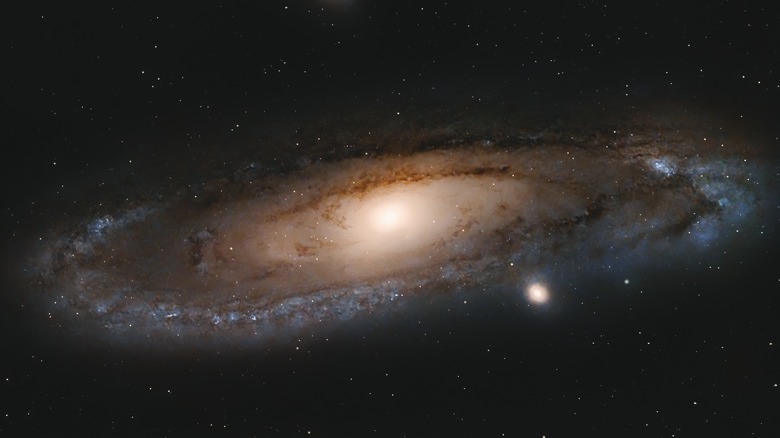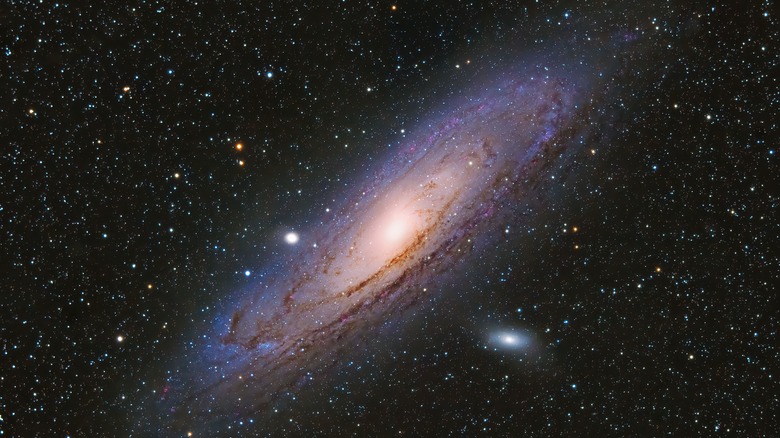The Milky Way Is Colliding With Another Galaxy. Here's What You Should Know
If you look up in the sky at night at Cassiopeia, you'll notice a faintly glowing object located just off Schedar, the constellation's brightest star. That's the Andromeda galaxy, our closest galactic neighbor, and in 4 billion years, it will collide with the Milky Way, throwing our solar system away from our own galactic core and reshaping the two galaxies into a single new, elliptical galaxy. That sounds dramatic, but the process will be gradual, much like how the Sun's death won't be an explosion, but something much slower. And thankfully, 4 billion years represents a time scale that none of us, our children, or even our great-great-great-great-grandchildren will ever have to worry about.
However, a new study has revealed a stunning twist to that future tale: The collision may have already begun right under our noses. Scientists at the Swinburne University of Technology recently published a paper in Nature Astronomy revealing that galaxies are wrapped in enormous shrouds of gas stretching up to a million light years into space — more than 10 times greater than a galaxy's starlight is capable of reaching.
The revelation comes from the first detailed photograph of this massive gas halo around a distant galaxy. Because the discovery suggests that we need to reconsider how we think of the "limits" of galaxies and how they interact (and even what exists beyond outer space), the Milky Way and Andromeda's own gaseous halos are likely already overlapping and intermingling. The great collision, it seems, has already begun, and this interaction could be influencing both galaxies in ways we're only beginning to understand.
Changing how we see galactic boundaries
Using the powerful Keck Cosmic Web Imager in Hawaii, scientists were able to obtain a comprehensive view of what's known as the circumgalactic medium (CGM), or gas halo, around IRAS08339+6517, a galaxy located roughly 270 million light years away from our own.
Somewhat counterintuitively, this gaseous envelope contains roughly 70% of a galaxy's visible mass. Due to limitations in imaging methodology and technology, however, the exact nature and details of CGMs have remained something of a mystery until recently. Using new deep imaging techniques, scientists were able to start drawing more finite lines between where galaxies end and where CGMs begin.
"We're now seeing where the galaxy's influence stops, the transition where it becomes part of more of what's surrounding the galaxy, and, eventually, where it joins the wider cosmic web and other galaxies. These are all usually fuzzy boundaries," said Dr. Nikole M. Nielsen, one of the study's authors in a statement (via Scimex).
A galactic collision course
The CGM, according to the paper's authors, plays a significant role in the cycling of the gas that makes up the majority of a galaxy's mass. Like the surprising discoveries of water in unexpected places beyond Earth, these massive gas halos are forcing scientists to rethink the basics of what they know of the universe, like how galaxies interact with their surroundings. This is why increasing our understanding of these regions may also lead to an increased understanding of the differences between galaxies themselves.
Far from being merely an academic exercise, all of these findings have direct implications for the oncoming merger between the Andromeda galaxy and our own. "It's highly likely that the CGMs of our own Milky Way and Andromeda are already overlapping and interacting," said Dr. Nielsen in a statement (via Scimex).
Time will tell, but as the Andromeda galaxy rushes toward our own at a speed of 250,000 mph, the interaction between the CGMs of each could have more immediate repercussions than scientists previously thought.


